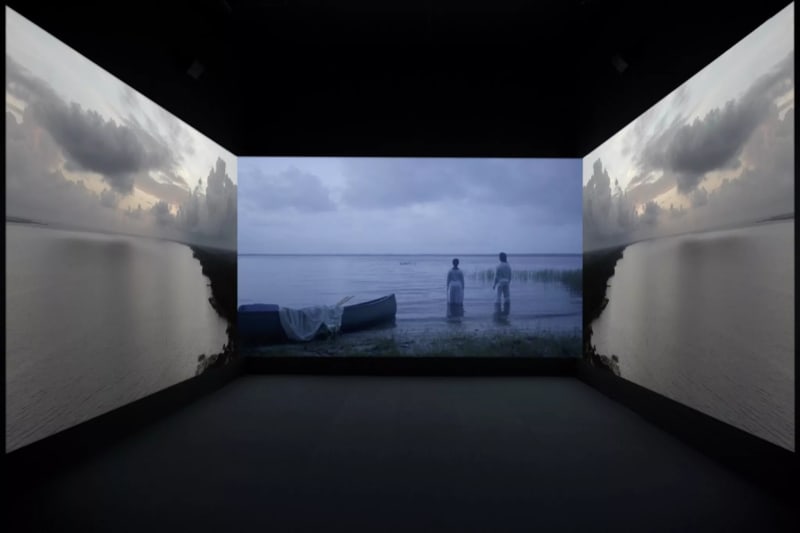BY AYANNA DOZIER
“Fight or flight” was the mantra for Black American life during the early part of the 20th century. Following the Reconstruction period in the late 19th century, Black Americans fled from or fought against intense racist violence in the deep South, most commonly in the form of lynchings. These patterns of migration are what led to the deep and booming settlements of Black communities across the United States.
The “Great Migration,” as this movement of 6 million Black Americans is known, is often seen as one fixed moment in time. Instead, it was an ongoing series of relocations where Black families or individuals uprooted their lives to find refuge elsewhere. A new exhibition at the Brooklyn Museum, “A Movement in Every Direction: Legacies of the Great Migration,” on view through June 25th, considers the haunting afterlife of the Great Migration through newly commissioned works by 12 contemporary Black artists: Akea Brionne, Mark Bradford, Zoë Charlton, Larry W. Cook, Torkwase Dyson, Theaster Gates, Allison Janae Hamilton, Leslie Hewitt, Steffani Jemison, Robert Pruitt, Jamea Richmond-Edwards, and Carrie Mae Weems.
The exhibition—conceived by curators Ryan N. Dennis and Jessica Bell Brown—premiered at the Mississippi Museum of Art in the spring of 2022 before traveling to the Baltimore Museum of Art in the fall. Kimberli Gant, curator of modern and contemporary art at the Brooklyn Museum, organized the exhibition’s New York presentation, with Indira A. Abiskaroon, the Museum’s curatorial assistant of modern and contemporary art.
Conceptually, the show is built around fragments of narratives, histories, and ideas. Take, for instance, Carrie Mae Weems’s striking installation of photographs The North Star (2022), comprising seven images of the North Star on inkjet prints in a horizontal line of black oval frames. The images appear, at first glance, like abstract color fields, as it takes time for the eye to adjust to the deep blues that capture the night sky. The star is a motif in the story of the artist’s grandfather, Frank Weems, who fled Arkansas to Chicago after being attacked by a white mob in 1936, never to return to his family. Weems suggests that her grandfather probably used that star, like so many others who fled before him, to make his way north.
“In this exhibition, the migration is a journey into the unknown,” Gant said to Artsy. “Like the Leviathan, a mythical beast that can help or destroy, and you don’t know [which] when you’re taking this journey—both in terms of the physical movement of family but also in breaking linkages [with] communities by leaving.”
Abstract and conceptual works in the show allow artists to gesture to this dead-of-night departure, without representing its trauma directly. Instead, the exhibition focuses on oral histories for its narrative weight. Visitors, for example, are invited to record their own audio to share their migratory experiences, and many of the artists’ family experiences with the Great Migration are described for context. These stories function as an invisible guide, investigating the trauma of fleeing inasmuch as they capture the spirit of self-determination.
Mark Bradford’s mixed-media installation wall piece 500 (2022) captures the resilience of his family, who moved west as part of a larger migration of Black communities fleeing Jim Crow laws. The work remixes an archival 1913 newspaper “Wanted” ad, calling for 500 families to live in an all-Black settlement of Blackdom, New Mexico. The listing is printed on multiple tiles of painted oxidized paper, each of which varies in legibility, pointing to the artist’s interest in repetition, signage, and language.
Elsewhere, artists use figuration and narrative works to collapse generational and geographical gaps. For Permanent Change of Station (2022), Zoë Charlton created a pop-up book of life-sized flora and fauna that originate in the Philippines and Vietnam but do not co-exist in nature. In keeping with Charlton’s practice of unpacking her familial history in her works, the work spotlights the narrative of Black soldiers who relocated to Southeast Asia following their time in the armed forces.
In Robert Pruitt’s A Song for Travelers (2022), audiences encounter a breathtakingly large-scale drawing where multiple generations of the Black diaspora meet a time/space traveler who represents Pruitt himself. The drawing is based on a family reunion photograph taken in the 1970s in Dobbin, Texas. Family members are captured mid-speech as they share their memories of life in East Texas and in Houston’s Third, Fourth, and Fifth Wards. The precision of Pruitt’s mesmerizing draftsmanship offers a tender portrayal of ancestors past, present, and future.
The Brooklyn iteration of the exhibition differs slightly from past stagings. Here, the show is presented in the Elizabeth Sackler gallery, which is dedicated to staging feminist art, women’s internal and external migration comes into sharper focus, with artists such as Steffani Jeminison and Theaster Gates animating these histories in their work. Akea Brionne’s jacquard rhinestone tapestry series “An Ode to (You)’all” (2022) pays homage to four important women in her family history who all made great sacrifices to support male family members who moved north for a chance at upward mobility. Family photographs of her great aunts (the Phelps sisters) and her great grandmother living in Mississippi deepen audiences’ understanding of Black motherhood in the South in the 1920s.
“Women’s historical contributions to the Great Migration…is a story that does not get discussed as much as it should,” said Gant. The exhibition also includes educational graphic representations of local migration patterns in Brooklyn, enabled, for instance, through the establishment of the A train, which brought Harlemites to the borough.
While many of the stories included in the show are deeply specific, they highlight larger patterns in society. As Gant concluded, “I hope that audiences will spend some time considering how we all have the same type of stories of migration and self-determination in our family history.”


